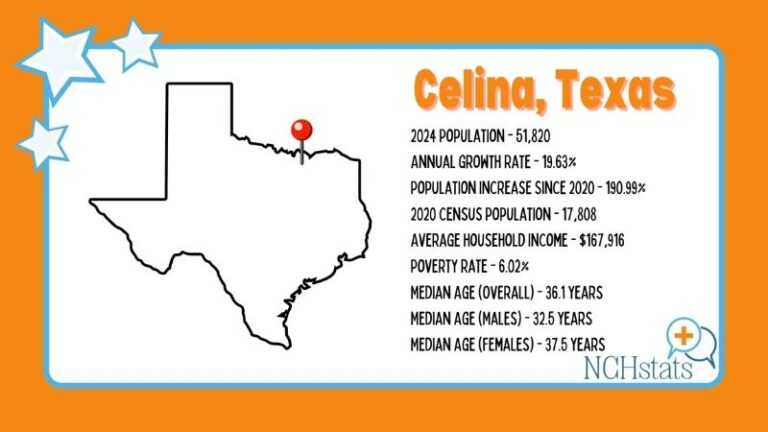Celina, Texas: A Model of Rapid Growth and Economic Vitality in the U.S.
Unprecedented Population Boom Fuels Celina’s Economic Transformation
Celina, Texas, has swiftly risen from a quiet suburban town to the fastest-growing city in the United States, drawing widespread attention for its explosive population increase. Over the last ten years, this surge has been propelled by a blend of affordable living, expanding employment prospects, and a welcoming environment for families. Positioned advantageously within the North Texas corridor, Celina offers residents easy access to major metropolitan hubs while preserving the charm and tranquility of suburban life. This unique combination has made it a preferred destination for young professionals and families seeking both opportunity and quality of life.
Economic growth in Celina is closely tied to this demographic expansion, with new enterprises emerging and significant investments flowing into infrastructure upgrades. City officials and business leaders are actively collaborating to address the challenges that accompany such rapid growth, focusing on enhancing transportation systems, expanding educational institutions, and promoting sustainable urban development. Key industries propelling Celina’s economy include:
- Residential and Commercial Real Estate: Meeting the surging demand for housing and business spaces.
- Retail and Service Sectors: Growing to support the increasing population’s needs.
- Technology and Innovation: Attracting startups and tech companies establishing regional offices.
| Year | Population Growth (%) | Jobs Added | Major Infrastructure Projects |
|---|---|---|---|
| 2021 | 12.4 | 1,200 | Three Road Expansion Projects |
| 2022 | 15.1 | 1,500 | New Community Recreation Center |
| 2023 | 14.7 | 1,700 | School Facility Expansions |
Key Drivers Behind Celina’s Explosive Growth
The extraordinary population increase in Celina stems from a synergy of factors that enhance both economic prospects and living standards. A thriving technology sector has been instrumental in attracting a dynamic, skilled workforce eager to settle in a city that harmonizes innovation with community values. Complementing this, Celina’s commitment to infrastructure development—such as improved transit routes and eco-friendly housing projects—has made it an accessible and desirable locale for families and professionals. The city’s reputation is further bolstered by top-tier schools, expansive parks, and recreational amenities that foster a well-rounded lifestyle.
Several localized elements have been pivotal in sustaining this momentum:
- Pro-Business Environment: Competitive tax incentives and streamlined regulatory processes encourage both startups and established firms to establish roots.
- Affordable Housing Availability: Offering cost-effective residential options amid a nationwide housing shortage.
- Community Involvement: Active neighborhood associations that promote safety and social cohesion.
| Growth Factor | Influence Level |
|---|---|
| Economic Diversification | High |
| Infrastructure Investment | Medium-High |
| Quality of Life Enhancements | High |
| Housing Affordability | Medium |
Despite these successes, Celina faces significant hurdles. The rapid pace of growth strains public services and infrastructure, necessitating careful fiscal management and strategic planning. Moreover, maintaining the city’s unique community character while embracing a more diverse population requires thoughtful urban design and inclusive policies. Balancing economic dynamism with social equity will be essential as Celina charts its future course.
Infrastructure and Housing: Pressures Mount Amid Population Surge
The swift influx of residents has intensified demands on Celina’s infrastructure and housing market, prompting urgent calls for comprehensive planning and investment. Transportation networks, utilities, and public amenities are under increasing pressure as new developments proliferate to accommodate the growing population. City planners must ensure that essential services such as water supply, waste management, and road capacity keep pace with expansion to avoid issues like traffic bottlenecks, water scarcity, and overburdened public facilities.
Simultaneously, the housing market has tightened considerably. Rising demand has pushed median home prices upward and reduced the availability of listings, creating challenges for many prospective buyers. Developers are striving to deliver affordable housing, but obstacles such as limited land availability, escalating construction expenses, and prolonged permitting processes complicate these efforts. Key challenges include:
- Scarcity of developable land
- Increasing costs of building materials and labor
- Lengthy approval timelines for new projects
To illustrate the market shift, consider the following comparison of housing metrics before and after Celina’s recent growth spurt:
| Year | Median Home Price | Average Days on Market | Active Listings |
|---|---|---|---|
| 2018 | $320,000 | 45 | 1,200 |
| 2023 | $450,000 | 22 | 650 |
Blueprint for Sustainable Growth: Strategic Recommendations
To maintain its upward trajectory while safeguarding community well-being, Celina must adopt a comprehensive strategy that integrates growth management with environmental responsibility. Essential approaches include:
- Smart Land Use Planning: Encouraging mixed-use developments to curb urban sprawl and protect natural areas.
- Robust Infrastructure Investment: Enhancing public transit, upgrading utilities, and expanding broadband access to meet rising demands.
- Affordable Housing Programs: Promoting diverse housing options to prevent displacement and foster inclusive neighborhoods.
Moreover, fostering collaboration between government entities and private sector stakeholders will be critical. Emphasizing innovation, workforce training, and sustainable practices can position Celina as a forward-thinking hub for emerging industries, while addressing challenges such as congestion, resource management, and climate adaptation.
| Focus Area | Recommended Action | Anticipated Benefit |
|---|---|---|
| Transportation | Expand public transit routes and develop bike-friendly infrastructure | Reduced traffic congestion and lower emissions |
| Housing | Incentivize construction of affordable, energy-efficient homes | More inclusive communities with smaller environmental footprints |
| Environmental Sustainability | Implement green infrastructure such as rain gardens and urban tree planting | Improved flood mitigation and urban heat reduction |
Conclusion: Navigating Growth with Vision and Balance
As Celina continues to lead the nation in population growth, it stands at a pivotal juncture. The city’s rapid expansion underscores the appeal of its economic opportunities but also highlights the urgent need for thoughtful, sustainable planning. Addressing infrastructure capacity, housing affordability, and community services will be vital to transforming growth into lasting prosperity. Celina’s approach to these challenges will offer valuable insights for other rapidly expanding cities across the country, serving as a blueprint for balancing progress with quality of life.







